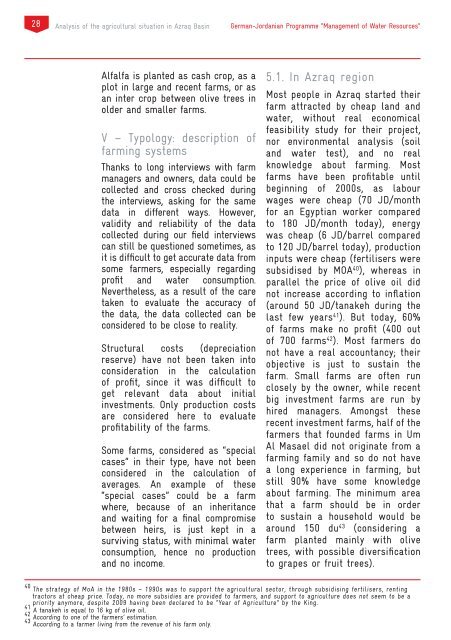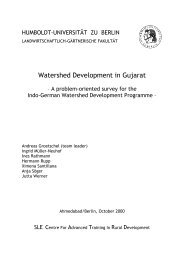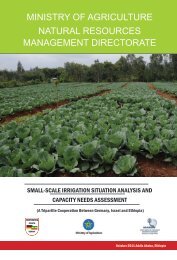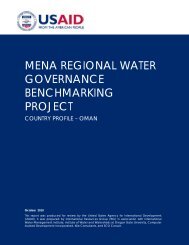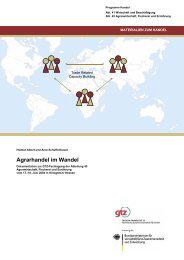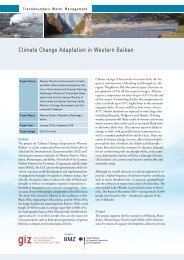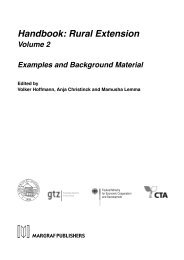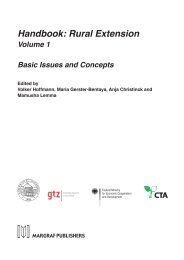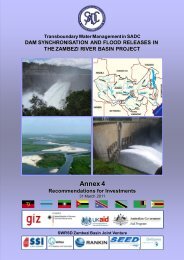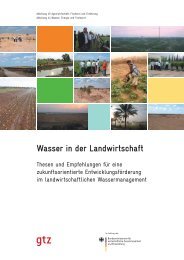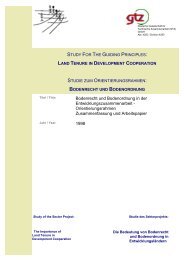Farming in the - WordPress.com
Farming in the - WordPress.com
Farming in the - WordPress.com
Create successful ePaper yourself
Turn your PDF publications into a flip-book with our unique Google optimized e-Paper software.
28<br />
Analysis of <strong>the</strong> agricultural situation <strong>in</strong> Azraq Bas<strong>in</strong><br />
German-Jordanian Programme “Management of Water Resources”<br />
Alfalfa is planted as cash crop, as a<br />
plot <strong>in</strong> large and recent farms, or as<br />
an <strong>in</strong>ter crop between olive trees <strong>in</strong><br />
older and smaller farms.<br />
V – Typology: description of<br />
farm<strong>in</strong>g systems<br />
Thanks to long <strong>in</strong>terviews with farm<br />
managers and owners, data could be<br />
collected and cross checked dur<strong>in</strong>g<br />
<strong>the</strong> <strong>in</strong>terviews, ask<strong>in</strong>g for <strong>the</strong> same<br />
data <strong>in</strong> different ways. However,<br />
validity and reliability of <strong>the</strong> data<br />
collected dur<strong>in</strong>g our field <strong>in</strong>terviews<br />
can still be questioned sometimes, as<br />
it is difficult to get accurate data from<br />
some farmers, especially regard<strong>in</strong>g<br />
profit and water consumption.<br />
Never<strong>the</strong>less, as a result of <strong>the</strong> care<br />
taken to evaluate <strong>the</strong> accuracy of<br />
<strong>the</strong> data, <strong>the</strong> data collected can be<br />
considered to be close to reality.<br />
Structural costs (depreciation<br />
reserve) have not been taken <strong>in</strong>to<br />
consideration <strong>in</strong> <strong>the</strong> calculation<br />
of profit, s<strong>in</strong>ce it was difficult to<br />
get relevant data about <strong>in</strong>itial<br />
<strong>in</strong>vestments. Only production costs<br />
are considered here to evaluate<br />
profitability of <strong>the</strong> farms.<br />
Some farms, considered as “special<br />
cases” <strong>in</strong> <strong>the</strong>ir type, have not been<br />
considered <strong>in</strong> <strong>the</strong> calculation of<br />
averages. An example of <strong>the</strong>se<br />
“special cases” could be a farm<br />
where, because of an <strong>in</strong>heritance<br />
and wait<strong>in</strong>g for a f<strong>in</strong>al <strong>com</strong>promise<br />
between heirs, is just kept <strong>in</strong> a<br />
surviv<strong>in</strong>g status, with m<strong>in</strong>imal water<br />
consumption, hence no production<br />
and no <strong>in</strong><strong>com</strong>e.<br />
5.1. In Azraq region<br />
Most people <strong>in</strong> Azraq started <strong>the</strong>ir<br />
farm attracted by cheap land and<br />
water, without real economical<br />
feasibility study for <strong>the</strong>ir project,<br />
nor environmental analysis (soil<br />
and water test), and no real<br />
knowledge about farm<strong>in</strong>g. Most<br />
farms have been profitable until<br />
beg<strong>in</strong>n<strong>in</strong>g of 2000s, as labour<br />
wages were cheap (70 JD/month<br />
for an Egyptian worker <strong>com</strong>pared<br />
to 180 JD/month today), energy<br />
was cheap (6 JD/barrel <strong>com</strong>pared<br />
to 120 JD/barrel today), production<br />
<strong>in</strong>puts were cheap (fertilisers were<br />
subsidised by MOA 40 ), whereas <strong>in</strong><br />
parallel <strong>the</strong> price of olive oil did<br />
not <strong>in</strong>crease accord<strong>in</strong>g to <strong>in</strong>flation<br />
(around 50 JD/tanakeh dur<strong>in</strong>g <strong>the</strong><br />
last few years 41 ). But today, 60%<br />
of farms make no profit (400 out<br />
of 700 farms 42 ). Most farmers do<br />
not have a real accountancy; <strong>the</strong>ir<br />
objective is just to susta<strong>in</strong> <strong>the</strong><br />
farm. Small farms are often run<br />
closely by <strong>the</strong> owner, while recent<br />
big <strong>in</strong>vestment farms are run by<br />
hired managers. Amongst <strong>the</strong>se<br />
recent <strong>in</strong>vestment farms, half of <strong>the</strong><br />
farmers that founded farms <strong>in</strong> Um<br />
Al Masael did not orig<strong>in</strong>ate from a<br />
farm<strong>in</strong>g family and so do not have<br />
a long experience <strong>in</strong> farm<strong>in</strong>g, but<br />
still 90% have some knowledge<br />
about farm<strong>in</strong>g. The m<strong>in</strong>imum area<br />
that a farm should be <strong>in</strong> order<br />
to susta<strong>in</strong> a household would be<br />
around 150 du 43 (consider<strong>in</strong>g a<br />
farm planted ma<strong>in</strong>ly with olive<br />
trees, with possible diversification<br />
to grapes or fruit trees).<br />
40 The strategy of MoA <strong>in</strong> <strong>the</strong> 1980s – 1990s was to support <strong>the</strong> agricultural sector, through subsidis<strong>in</strong>g fertilisers, rent<strong>in</strong>g<br />
tractors at cheap price. Today, no more subsidies are provided to farmers, and support to agriculture does not seem to be a<br />
priority anymore, despite 2009 hav<strong>in</strong>g been declared to be “Year of Agriculture” by <strong>the</strong> K<strong>in</strong>g.<br />
41 A tanakeh is equal to 16 kg of olive oil.<br />
42 Accord<strong>in</strong>g to one of <strong>the</strong> farmers’ estimation.<br />
43 Accord<strong>in</strong>g to a farmer liv<strong>in</strong>g from <strong>the</strong> revenue of his farm only.


